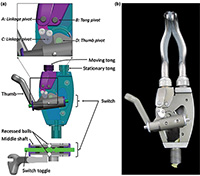
Photograph courtesy of the Journal of Rehabilitation Research & Development.
Body-powered prostheses use cable-operated systems to generate forces and move prosthetic joints, and can only control either voluntary opening (VO) or voluntary closing (VC). Both modes provide advantages when completing certain tasks; and many end users desire a terminal device (TD) that can switch between the two modes. A study, published in Volume 52, Number 1, 2015, of the Journal of Rehabilitation Research & Development (JRRD), describes the design concept and evaluation of a rugged, split-hook, body-powered TD that permits the user to switch between VO and VC.
In the pilot study, five people with intact arms and two people with amputations used the VO/VC split-hook prehensor to perform the Southampton Hand Assessment Procedure (SHAP). The results show an average improvement of four to seven points on the SHAP when users could choose to switch between modes on a task-by-task basis than when they were constrained to using only VO or VC modes, according to the study’s authors.
The authors noted that a TD that can switch between both modes is of benefit to the end user, but it must maintain thumb position and movement direction in both modes in order to avoid readjustment of the harness after every mode switch.
A larger clinical study for this device is currently under way.




